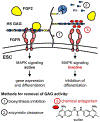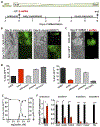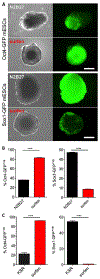Small Molecule Antagonist of Cell Surface Glycosaminoglycans Restricts Mouse Embryonic Stem Cells in a Pluripotent State
- PMID: 28984039
- PMCID: PMC6237099
- DOI: 10.1002/stem.2714
Small Molecule Antagonist of Cell Surface Glycosaminoglycans Restricts Mouse Embryonic Stem Cells in a Pluripotent State
Abstract
Recently, the field of stem cell-based regeneration has turned its attention toward chemical approaches for controlling the pluripotency and differentiation of embryonic stem cells (ESCs) using drug-like small molecule modulators. Growth factor receptors or their associated downstream kinases that regulate intracellular signaling pathways during differentiation are typically the targets for these molecules. The glycocalyx, which plays an essential role in actuating responses to growth factors at the cellular boundary, offers an underexplored opportunity for intervention using small molecules to influence differentiation. Here, we show that surfen, an antagonist of cell-surface glycosaminoglycans required for growth factor association with cognate receptors, acts as a potent and general inhibitor of differentiation and promoter of pluripotency in mouse ESCs. This finding shows that drugging the stem cell Glycome with small molecules to silence differentiation cues can provide a powerful new alternative to existing techniques for controlling stem cell fate. Stem Cells 2018;36:45-54.
Keywords: Carbohydrate; Differentiation; Embryonic stem cell; Fibroblast growth factors; Heparan sulfate; Pluripotency.
© 2017 AlphaMed Press.
Conflict of interest statement
Disclosure of Potential Conflicts of Interest
The authors indicated no potential conflicts of interest.
Figures






References
-
- Hochedlinger K, Jaenisch R. Nuclear transplantation, embryonic stem cells, and the potential for cell therapy. N Engl J Med 2003;349:275–286. - PubMed
-
- Wernig M, Meissner A, Foreman R et al. In vitro reprogramming of fibroblasts into a pluripotent ES-cell-like state. Nature 2007; 448:318–324. - PubMed
-
- Okita K, Ichisaka T, Yamanaka S. Generation of germline-competent induced pluripotent stem cells. Nature 2007;448:313–317. - PubMed
-
- Ledermann B Embryonic stem cells and gene targeting. Exp Physiol 2000;85:603–613. - PubMed
Publication types
MeSH terms
Substances
Grants and funding
LinkOut - more resources
Full Text Sources
Other Literature Sources

